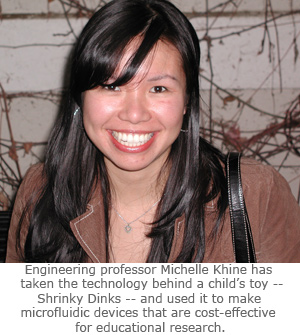

To see UC Merced students using Shrinky Dinks and PDMS to conduct research, check out a 7-minute video on the process by clicking
here.
Microfluidic devices play an important part in cell assay for diagnosis of diseases and in cancer research. Usually, though, creating microfluidics is prohibitively expensive for academic researchers, not to mention their students.
UC Merced
engineeringprofessor Michelle Khine has set change in motion for microfluidics, helping explore a new medium that may make the field more accessible. That new medium is the children’s toy,
Shrinky Dinks.
After printing the desired chip pattern on a sheet of Shrinky Dinks polystyrene plastic using a laser printer, Khine’s team shrinks the material using the standard kitchen-oven method. The result is a 60 percent decrease in width - and a 500 percent increase in the height of the printed areas.
People have done this before with laser printing on transparencies, said Khine’s student assistant, Anthony Grimes, a junior from Oakhurst majoring in
bioengineeringwho is working on the project. But the resulting chips don’t have channels deep enough for cell assay.
The shrinking clearly makes the difference.
The resulting molds are used to shape a silicon-like material called polydimethylsiloxane, or PDMS, into microfluidic devices. However, there are some challenges to this method. PDMS can absorb proteins and affect the outcome of a test, and sometimes its soft consistency can’t handle the pressure of the fluid flowing through it.
Khine’s team had to come up with a new approach. They realized that instead of adding material using a laser printer, they could remove material by etching the polystyrene plastic, creating the actual device instead of just a mold.
This eliminates the problem of using PDMS, creates better resolution and allows us to create three-dimensional devices where different fluid channels can cross without mixing, Grimes explained. We can fuse several layers of Shrinky Dinks together using only heat.
And the team is exploring other properties of their new favorite toy, as well.
If they fuse a thin layer of gold to the plastic sheet, a complex and beautiful pattern of wrinkles emerges when the materials are heated and shrunk. Different application techniques - like using a metal screen as a template to apply the gold in tiny, separate squares - create different patterns.
We think this technique could be useful for optics or other applications where we want to increase surface area in a small space, Grimes said.
The team already has published two papers in the journal, Lab on a Chip, about their Shrinky Dinks research, and a third is forthcoming. Experience like this will make a difference for Grimes, who plans to pursue a Ph.D. in bioengineering, and for other undergrads working in Khine’s lab.






